Contribution of Climatic Factors and Human Activities to Vegetation Changes in Arid Grassland
Abstract
1. Introduction
2. Materials and Methods
2.1. Study Area
2.2. Data Source and Preprocessing
2.3. Research Methods
2.3.1. Trend Analysis, Correlation Analysis, and Forecasting of Future Trends
2.3.2. Relationship between Vegetation and Influencing Factors
2.3.3. The Environment for Calculations
3. Results
3.1. Temporal and Spatial Changes in Vegetation in the Yinshanbeilu Grassland Region
3.1.1. Spatial Variation Trend in NDVI
3.1.2. Seasonal Changes in NDVI
3.2. Relationship between Vegetation Change and Climate Factors
3.2.1. Temporal and Spatial Changes in Climate Factors
3.2.2. Correlations between NDVI and Various Climate Factors
3.3. Impact of Climate Change and Human Factors on Vegetation Changes
3.3.1. Contribution of Climate Change to Vegetation Changes
3.3.2. Contribution of Human Factors to Vegetation Change
3.4. Trends in Future Changes in Vegetation
4. Discussion
4.1. NDVI Change Rate of Vegetation for the Yinshanbeilu Grassland Region
4.2. Impact of Climate Factors on Vegetation Changes
4.2.1. Precipitation Affects Vegetation Changes
4.2.2. Effects of Other Climatic Factors on Vegetation
4.3. Influence of Human Factors on Vegetation Change
4.4. Limitation
5. Conclusions
Author Contributions
Funding
Institutional Review Board Statement
Informed Consent Statement
Data Availability Statement
Conflicts of Interest
References
- Jong, R.; de Bruin, S.; de Wit, A.; Schaepman, M.E.; Dent, D.L. Analysis of monotonic greening and browning trends from global NDVI time-series. Remote Sens. Environ. 2011, 115, 692–702. [Google Scholar] [CrossRef]
- Wang, X.; Piao, S.; Ciais, P.; Li, J.; Friedlingstein, P.; Koven, C.; Chen, A. Spring temperature change and its implication in the change of vegetation growth in North America from 1982 to 2006. Proc. Natl. Acad. Sci. USA 2011, 4, 1240–1245. [Google Scholar] [CrossRef] [PubMed]
- Zhang, J.; Zhang, L.; Xu, C.; Liu, W.; Qi, Y.; Wo, X. Vegetation variation of mid-subtropical forest based on MODIS NDVI data—A case study of Jinggangshan City, Jiangxi Province. Acta Ecol. Sin. 2014, 34, 7–12. [Google Scholar] [CrossRef]
- Wang, J.; Wang, K.; Zhang, M.; Zhang, C. Impacts of climate change and human activities on vegetation cover in hilly southern China. Ecol. Eng. 2015, 81, 451–461. [Google Scholar] [CrossRef]
- Zheng, K.; Wei, J.; Pei, J.; Cheng, H.; Zhang, X.; Huang, F.; Li, F.; Ye, J. Impacts of climate change and human activities on grassland vegetation variation in the Chinese Loess Plateau. Sci. Total Environ. 2019, 660, 236–244. [Google Scholar] [CrossRef]
- Ren, Y.; Zhang, F.; Zhao, C.; Cheng, Z. Attribution of climate change and human activities to vegetation NDVI in Jilin Province, China during 1998–2020. Ecol. Indic. 2023, 153, 110415. [Google Scholar] [CrossRef]
- Cai, H.; Yang, X.; Wang, K.; Xiao, L. Is Forest Restoration in the Southwest China Karst Promoted Mainly by Climate Change or Human-Induced Factors? Remote Sens. 2014, 6, 9895–9910. [Google Scholar] [CrossRef]
- Li, X.; Xu, X.; Tian, W.; Tian, J.; He, C. Contribution of climate change and vegetation restoration to interannual variability of evapotranspiration in the agro-pastoral ecotone in northern China. Ecol. Indic. 2021, 154, 110485. [Google Scholar] [CrossRef]
- Yan, Y.; Liu, X.; Wen, Y.; Ou, J. Quantitative analysis of the contributions of climatic and human factors to grassland productivity in northern China. Ecol. Indic. 2019, 103, 542–553. [Google Scholar] [CrossRef]
- Bai, X.; Fu, J.; Li, Y.; Li, Z. Attributing vegetation change in an arid and cold watershed with complex ecosystems in northwest China. Ecol. Indic. 2022, 138, 108835. [Google Scholar] [CrossRef]
- Ren, Z.; Tian, Z.; Wei, H.; Liu, Y.; Yu, Y. Spatiotemporal evolution and driving mechanisms of vegetation in the Yellow River Basin, China during 2000–2020. Ecol. Indic. 2022, 138, 108832. [Google Scholar] [CrossRef]
- Wang, J.; Ding, Y.; Wang, S.; Watson, A.E.; He, H.; Ye, H.; Ouyang, X.; Li, Y. Pixel-scale historical-baseline-based ecological quality: Measuring impacts from climate change and human activities from 2000 to 2018 in China. J. Environ. Manag. 2022, 313, 114944. [Google Scholar] [CrossRef]
- Banerjee, A.; Kang, S.; Meadows, M.E.; Xia, Z.; Sengupta, D.; Kumar, V. Quantifying climate variability and regional anthropogenic influence on vegetation dynamics in northwest India. Environ. Res. 2023, 234, 116541. [Google Scholar] [CrossRef]
- Sin, L.; Zhao, D.; Zhang, G.; Wu, X.; Yang, Y.; Wang, Z. Using SPOT VEGETATION for analyzing dynamic changes and influencing factors on vegetation restoration in the Three-River Headwaters Region in the last 20 years (2000–2019), China. Ecol. Eng. 2022, 183, 106742. [Google Scholar] [CrossRef]
- Xu, M.; Xu, G.; Li, Z.; Dang, Y.; Li, Q.; Min, Z.; Gu, F.; Wang, B.; Liu, S.; Zhang, Y. Effects of comprehensive landscape patterns on water quality and identification of key metrics thresholds causing its abrupt changes. Environ. Pollut. 2023, 333, 122097. [Google Scholar] [CrossRef]
- Huo, T.; Wang, J.; Zhang, Y.; Wei, B.; Chen, K.; Zhuang, M.; Liu, N.; Zhang, Y.; Liang, J. Temperate grassland vegetation restoration influenced by grazing exclusion and climate change. Sci. Total Environ. 2024, 912, 168842. [Google Scholar] [CrossRef]
- Hu, W.; Wu, X.; Zhang, K. Spatiotemporal change of beneficiary area from wind erosion prevention service in the Ulan Buh Desert in 2008 and 2018. Geogr. Sustain. 2022, 3, 119–128. [Google Scholar] [CrossRef]
- Chi, H.; Wu, Y.; Zheng, H.; Zhang, B.; Sun, Z.; Yan, J.; Ren, Y.; Guo, L. Spatial patterns of climate change and associated climate hazards in Northwest China. Sci. Rep. 2023, 13, 10418. [Google Scholar] [CrossRef]
- Williams, E.L.; Funk, C.; Shukla, S. Anthropogenic Climate Change Negatively Impacts Vegetation and Forage Conditions in the Greater Four Corners Region. Earth Future 2023, 11, e2022EF002943. [Google Scholar] [CrossRef]
- Yu, Y.; Zhan, L.; Wang, D.; Hu, D. Thoughts on comprehensive management of forest and grass ecology at the northern foot of Yinshan Mountain in Ulanqab City of Inner Mongolia. Inner Mongolia Forestry Investig. Des. 2022, 45, 6–8. [Google Scholar] [CrossRef]
- Zhang, H.; Fan, J.; Cao, W.; Zhong, H.; Harris, W.; Gong, G.; Zhang, Y. Changes in multiple ecosystem services between 2000 and 2013 and their driving factors in the Grazing Withdrawal Program, China. Ecol. Eng. 2018, 116, 67–79. [Google Scholar] [CrossRef]
- Yin, Y.; Hou, Y.; Langford, C.; Bai, H.; Hou, X. Herder stocking rate and household income under the Grassland Ecological Protection Award Policy in northern China. Land Use Pol. 2019, 82, 120–129. [Google Scholar] [CrossRef]
- Yan, H.; Xue, Z.; Niu, Z. Ecological restoration policy should pay more attention to the high productivity grasslands. Ecol. Indic. 2021, 129, 107938. [Google Scholar] [CrossRef]
- Wang, S.; Wang, W.; Wu, Y.; Li, W.; Zhao, S.; Chen, Z. Effects of a changing climate and anthropogenic impacts on net primary production in Yinshanbeilu, Inner Mongolia, China. Environ. Impact Asses. Rev. 2023, 102, 107185. [Google Scholar] [CrossRef]
- Zhao, Y.; Yang, S.; Liu, L.; Jia, X.; Han, L.; Yuan, X.; Zhao, M.; Zhang, P. Variations and driving mechanisms of desertification in the southeast section of the China-Mongolia-Russia Economic Zone. Sci. Total Environ. 2023, 887, 164004. [Google Scholar] [CrossRef]
- Du, Z.; Ding, S.; Xiao, R.; Fang, C.; Jia, R.; Chu, W. Disinfection by-product precursors introduced by sandstorm events: Composition, formation characteristics and potential risks. Water Res. 2023, 244, 120429. [Google Scholar] [CrossRef]
- Wang, N.; Zhang, Q.; Sun, S.; Yang, W.; Zhang, Y.; Zhai, Y.; Liu, H.; Wang, H.; He, M.; Fan, P.; et al. Sandstorms in the Yellow River Basin, China in the 21st century: Spatiotemporal pattern and variation trend. Ecol. Indic. 2023, 154, 110601. [Google Scholar] [CrossRef]
- Wang, B.; Xu, G.; Li, P.; Li, Z.; Zhang, Y.; Cheng, Y.; Jia, L.; Zhang, J. Vegetation dynamics and their relationships with climatic factors in the Qinling Mountains of China. Ecol. Indic. 2020, 108, 105719. [Google Scholar] [CrossRef]
- Zhu, L.; Sun, S.; Li, Y.; Liu, X.; Hu, K. Effects of climate change and anthropogenic activity on the vegetation greening in the Liaohe River Basin of northeastern China. Ecol. Indic. 2023, 148, 110105. [Google Scholar] [CrossRef]
- Peng, W.; Kuang, T.; Tao, S. Quantifying influences of natural factors on vegetation NDVI changes based on geographical detector in Sichuan, western China. J. Clean. Prod. 2019, 233, 353–367. [Google Scholar] [CrossRef]
- Huo, H.; Sun, C. Spatiotemporal variation and influencing factors of vegetation dynamics based on Geodetector: A case study of the northwestern Yunnan Plateau, China. Ecol. Indic. 2021, 130, 108005. [Google Scholar] [CrossRef]
- Song, Y.; Ma, M.; Veroustraete, F. Comparison and conversion of AVHRR GIMMS and SPOT VEGETATION NDVI data in China. Int. J. Remote Sens. 2010, 31, 2377–2392. [Google Scholar] [CrossRef]
- Mann, H.B. Nonparametric tests against trend. Econometrica 1945, 13, 245–259. Available online: https://www.jstor.org/stable/1907187 (accessed on 5 October 2023). [CrossRef]
- Kendall, M.G. Rank Correlation Measures; Charles Griffin: London, UK, 1975. [Google Scholar]
- Zhang, Y.; Gong, J.; Yang, J.; Peng, J. Evaluation of Future Trends Based on the Characteristics of Net Primary Production (NPP) Changes over 21 Years in the Yangtze River Basin in China. Sustainability 2023, 15, 10606. [Google Scholar] [CrossRef]
- Potter, C.S.; Brooks, V. Global analysis of empirical relations between annual climate and seasonality of NDVI. Int. J. Remote Sens. 1998, 19, 2921–2948. [Google Scholar] [CrossRef]
- Piao, S.; Mohammat, A.; Fang, J.; Cai, Q.; Feng, J. NDVI-based increase in growth of temperate grasslands and its responses to climate changes in China. Glob. Environ. Chang.-Hum. Policy Dimens. 2006, 16, 340–348. [Google Scholar] [CrossRef]
- Ma, Y.; Huang, N.; Ma, C. Heterogeneity, marginality, stagementation and driving forces in the Otindag Sandy Land and its ecotones based on GIMMS NDVI3g v1.0. Ecol. Inform. 2023, 77, 102187. [Google Scholar] [CrossRef]
- Hurst, H.E. Long–term storage capacity of reservoirs. Trans. Am. Soc. Civ. Eng. 1951, 116, 770–808. [Google Scholar] [CrossRef]
- Rao, A.R.; Bhattacharya, D. Comparison of Hurst exponent estimates in hydrometeorological time series. J. Hydrol. Eng. 1999, 4, 4225–4231. [Google Scholar] [CrossRef]
- Zhang, B.; Wu, P.; Zhao, X.; Gao, X.; Shi, Y. Assessing the spatial and temporal variation of the rainwater harvesting poten-tial (1971–2010) on the Chinese Loess Plateau using the VIC model. Hydrol. Process. 2014, 28, 534–544. [Google Scholar] [CrossRef]
- Rehman, S. Study of Saudi Arabian climatic conditions using Hurst exponent and climatic predictability index. Chaos Solitons Fractals 2009, 39, 499–509. [Google Scholar] [CrossRef]
- Xu, G.; Zhang, J.; Li, P.; Li, Z.; Lu, K.; Wang, X.; Wang, F.; Cheng, Y.; Wang, B. Vegetation restoration projects and their influence on runoff and sediment in China. Ecol. Indic. 2018, 95, 233–241. [Google Scholar] [CrossRef]
- Marin-Lopez, A.; Martínez-Cadena, J.A.; Martinez-Martinez, F.; Alvarez-Ramirez, J. Surrogate multivariate Hurst exponent analysis of gait dynamics. Chaos Solitons Fractals 2023, 172, 113605. [Google Scholar] [CrossRef]
- Zhang, Y.; Zhang, C.; Wang, Z.; Chen, Y.; Gang, C.; An, R.; Li, J. Vegetation dynamics and its driving forces from climate change and human activities in the Three-River Source Region, China from 1982 to 2012. Sci. Total Environ. 2016, 563–564, 210–220. [Google Scholar] [CrossRef]
- Cao, M.; Woodward, F.I. Dynamic responses of terrestrial ecosystem carbon cycling to global climate change. Nature 1998, 393, 249–252. [Google Scholar] [CrossRef]
- Zhu, L.; Southworth, J. Disentangling the Relationships between Net Primary Production and Precipitation in Southern Africa Savannas Using Satellite Observations from 1982 to 2010. Remote Sens. 2013, 5, 3803–3825. [Google Scholar] [CrossRef]
- Chen, A.; He, B.; Wang, H.; Huang, L.; Zhu, Y.; Lv, A. Notable shifting in the responses of vegetation activity to climate change in China. Phys. Chem. Earth 2015, 87–88, 60–66. [Google Scholar] [CrossRef]
- Huang, F.; Xu, S. Spatio-Temporal Variations of Rain-Use Efficiency in the West of Songliao Plain, China. Sustainability 2016, 8, 308. [Google Scholar] [CrossRef]
- Wei, Y.; Sun, S.; Liang, D.; Jia, Z. Spatial-temporal variations of NDVI and its response to climate in China from 2001 to 2020. Int. J. Digit. Earth 2022, 15, 1463–1484. [Google Scholar] [CrossRef]
- Meng, S.; Xie, X.; Zhu, B.; Wang, Y. The relative contribution of vegetation greening to the hydrological cycle in the Three-North region of China: A modelling analysis. J. Hydrol. 2020, 591, 125689. [Google Scholar] [CrossRef]
- Wu, D.; Xie, X.; Tong, J.; Meng, S.; Wang, Y. Sensitivity of Vegetation Growth to Precipitation in a Typical Afforestation Area in the Loess Plateau: Plant-Water Coupled Modelling. Ecol. Model. 2020, 430, 109128. [Google Scholar] [CrossRef]
- Zhang, H.; Yang, X.; Yang, D.; Chen, A.; Zhang, M. Spatio-temporal changes in grassland fractional vegetation cover in Inner Mongolia from 2000 to 2020 and a future forecast. Acta Prataculturae Sin. 2023, 32, 1–13. [Google Scholar] [CrossRef]
- Tian, H.; Cao, C.; Chen, W.; Bao, S.; Yang, B.; Myneni, R.B. Response of vegetation activity dynamic to climatic change and ecological restoration programs in Inner Mongolia from 2000 to 2012. Ecol. Eng. 2015, 82, 276–289. [Google Scholar] [CrossRef]
- Yang, L.; Wylie, B.K.; Tieszen, L.L.; Reed, B.C. An Analysis of Relationships among Climate Forcing and Time-Integrated NDVI of Grasslands over the U.S. Northern and Central Great Plains. Remote Sens. Environ. 1998, 65, 25–37. [Google Scholar] [CrossRef]
- Bai, Y.; Guo, C.; Degen, A.A.; Ahmad, A.A.; Wang, W.; Zhang, T.; Li, W.; Ma, L.; Huang, M.; Zeng, H.; et al. Climate warming benefits alpine vegetation growth in Three-River Headwater Region, China. Sci. Total Environ. 2020, 742, 140574. [Google Scholar] [CrossRef] [PubMed]
- Zhang, X.; Jin, X. Vegetation dynamics and responses to climate change and anthropogenic activities in the Three-River Headwaters Region, China. Ecol. Indic. 2021, 131, 108223. [Google Scholar] [CrossRef]
- Luan, J.; Miao, P.; Tian, X.; Li, X.; Ma, N.; Abrar Faiz, M.; Xu, Z.; Zhang, Y. Estimating hydrological consequences of vegetation greening. J. Hydrol. 2022, 611, 128018. [Google Scholar] [CrossRef]
- Liu, Y.; Liu, H.; Chen, Y.; Gang, C.; Shen, Y. Quantifying the contributions of climate change and human activities to vegetation dynamic in China based on multiple indices. Sci. Total Environ. 2022, 838, 156553. [Google Scholar] [CrossRef]
- Zhan, Y.; Ma, C.; Yan, Y.; Zhu, J.; Ji, Y.; Ma, C.; Luo, Y. Spatial differentiation characteristics of vegetation greening rates and climate attribution in China’s arid and semi-arid regions. Glob. Ecol. Conserv. 2023, 46, e2563. [Google Scholar] [CrossRef]
- Zhao, Y.; Hu, C.; Dong, X.; Li, J. NDVI Characteristics and Influencing Factors of Typical Ecosystems in the Semi-Arid Region of Northern China: A Case Study of the Hulunbuir Grassland. Land 2023, 12, 713. [Google Scholar] [CrossRef]
- Bai, X.Y.; Fan, Z.M.; Yue, T.X. Dynamic pattern-effect relationships between precipitation and vegetation in the semi-arid and semi-humid area of China. CATENA 2023, 232, 107425. [Google Scholar] [CrossRef]
- Hu, M.Q.; Mao, F.; Sun, H.; Hou, Y.Y. Study of normalized difference vegetation index variation and its correlation with climate factors in the three-river-source region. Int. J. Appl. Earth Obs. Geoinf. 2011, 13, 24–33. [Google Scholar] [CrossRef]
- Gu, W.; Zhu, X.; Meng, X.; Qiu, X. Research on the Influence of Small-Scale Terrain on Precipitation. Water 2021, 13, 805. [Google Scholar] [CrossRef]
- Li, Z.; Qu, H.; Li, L.; Zheng, J.; Wei, D.; Wang, F. Effects of climate change on vegetation dynamics of the Qinghai-Tibet Plateau, a causality analysis using empirical dynamic modeling. Heliyon 2023, 9, e16001. [Google Scholar] [CrossRef] [PubMed]
- Liu, Y.Y.; Evans, J.P.; McCabe, M.F.; de Jeu, R.A.; van Dijk, A.I.; Dolman, A.J.; Saizen, I. Changing climate and overgrazing are decimating Mongolian steppes. PLoS ONE 2013, 8, e57599. [Google Scholar] [CrossRef] [PubMed]
- Lou, P.; Wu, T.; Yang, S.; Wu, X.; Chen, J.; Zhu, X.; Chen, J.; Lin, X.; Li, R.; Shang, C.; et al. Deep learning reveals rapid vegetation greening in changing climate from 1988 to 2018 on the Qinghai-Tibet Plateau. Ecol. Indic. 2023, 148, 110020. [Google Scholar] [CrossRef]
- Chen, J.; Wang, Y.; Sun, J.; Liang, E.; Shen, M.; Yang, B.; Jia, X.; Zhang, J. Precipitation dominates synergies and trade-offs among ecosystem services across the Qinghai-Tibet Plateau. Glob. Ecol. Conserv. 2021, 32, e01886. [Google Scholar] [CrossRef]
- Zhang, Y.; Jiang, X.; Lei, Y.; Gao, S. The contributions of natural and anthropogenic factors to NDVI variations on the Loess Plateau in China during 2000–2020. Ecol. Indic. 2022, 143, 109342. [Google Scholar] [CrossRef]
- Chuai, X.W.; Huang, X.J.; Wang, W.J.; Bao, G. NDVI, temperature and precipitation changes and their relationships with different vegetation types during 1998-2007 in Inner Mongolia, China. Int. J. Climatol. 2013, 33, 1696–1706. [Google Scholar] [CrossRef]
- Sardiña, L.C.; Irisarri, G.; Texeira, M. Climate factors rather than human activities controlled NDVI trends across wet meadow areas in the Andes Centrales of Argentina. J. Arid. Environ. 2023, 214, 104983. [Google Scholar] [CrossRef]
- Li, R.; Zhao, L.; Ding, Y.; Wang, S.; Ji, G.; Xiao, Y.; Liu, G.; Sun, L. Monthly ratios of PAR to global solar radiation measured at northern Tibetan Plateau, China. Sol. Energy 2010, 84, 964–973. [Google Scholar] [CrossRef]
- Yang, T.; Hao, X.; Shao, Q.; Xu, C.; Zhao, C.; Chen, X.; Wang, W. Multi-model ensemble projections in temperature and precipitation extremes of the Tibetan Plateau in the 21st century. Glob. Planet. Change 2012, 80–81, 1–13. [Google Scholar] [CrossRef]
- Zuo, Y.; Li, Y.; He, K.; Wen, Y. Temporal and spatial variation characteristics of vegetation coverage and quantitative analysis of its potential driving forces in the Qilian Mountains, China, 2000–2020. Ecol. Indic. 2022, 143, 109429. [Google Scholar] [CrossRef]
- Guo, W.; Huang, S.; Huang, Q.; She, D.; Shi, H.; Leng, G.; Li, J.; Cheng, L.; Gao, Y.; Peng, J. Precipitation and vegetation transpiration variations dominate the dynamics of agricultural drought characteristics in China. Sci. Total Environ. 2023, 898, 165480. [Google Scholar] [CrossRef]
- Jia, Z.; Lei, R.; Liu, Y.; Liu, P.; Wang, Z.; Chang, Y.; Wei, W. Spatial–Temporal Variations and the Driving Factors of Vegetation Coverage in the Loess Hilly and Gully Region of China. Forests 2023, 14, 1238. [Google Scholar] [CrossRef]
- Yang, S.; Liu, J.; Wang, C.; Zhang, T.; Dong, X.; Liu, Y. Vegetation dynamics influenced by climate change and human activities in the Hanjiang River Basin, central China. Ecol. Indic. 2022, 145, 109586. [Google Scholar] [CrossRef]
- Sun, Y.L.; Shan, M.; Pei, X.R.; Zhang, X.K.; Yang, Y.L. Assessment of the impacts of climate change and human activities on vegetation cover change in the Haihe River basin, China. Phys. Chem. 2020, 115, 102834. [Google Scholar] [CrossRef]
- Ning, X.; Zhu, N.; Liu, Y.; Wang, H. Quantifying impacts of climate and human activities on the grassland in the Three-River Headwater Region after two phases of Ecological Project. Geogr. Sustain. 2022, 3, 164–176. [Google Scholar] [CrossRef]
- Saizen, I.; Maekawa, A.; Yamamura, N. Spatial analysis of time-series changes in livestock distribution by detection of local spatial associations in Mongolia. Appl. Geogr. 2010, 30, 639–649. [Google Scholar] [CrossRef]
- Zhao, L.; Jia, K.; Liu, X.; Li, J.; Xia, M. Assessment of land degradation in Inner Mongolia between 2000 and 2020 based on remote sensing data. Geogr. Sustain. 2023, 4, 100–111. [Google Scholar] [CrossRef]
- Xu, L.; Gao, G.; Wang, X.; Chen, Y.; Zhou, C.; Wang, K.; Fu, B. Quantifying the contribution of climate change and human activities to vegetation greening in the drylands of northern China. Acta Ecol. Sin. 2023, 43, 1–10. [Google Scholar] [CrossRef]
- Gao, W.; Zheng, C.; Liu, X.; Lu, Y.; Chen, Y.; Wei, Y.; Ma, Y. NDVI-based vegetation dynamics and their responses to climate change and human activities from 1982 to 2020: A case study in the Mu Us Sandy Land, China. Ecol. Indic. 2022, 137, 108745. [Google Scholar] [CrossRef]
- Cheng, Y.; Xu, G.; Wang, X.; Li, P.; Dang, X.; Jiang, W.; Ma, T.; Wang, B.; Gu, F.; Li, Z. Contribution of soil aggregate particle size to organic carbon and the effect of land use on its distribution in a typical small watershed on Loess Plateau, China. Ecol. Indic. 2023, 155, 110988. [Google Scholar] [CrossRef]
- Wang, B.; Xu, G.; Ma, T.; Chen, L.; Cheng, Y.; Li, P.; Li, Z.; Zhang, Y. Effects of vegetation restoration on soil aggregates, organic carbon, and nitrogen in the Loess Plateau of China. CATENA 2023, 231, 107340. [Google Scholar] [CrossRef]
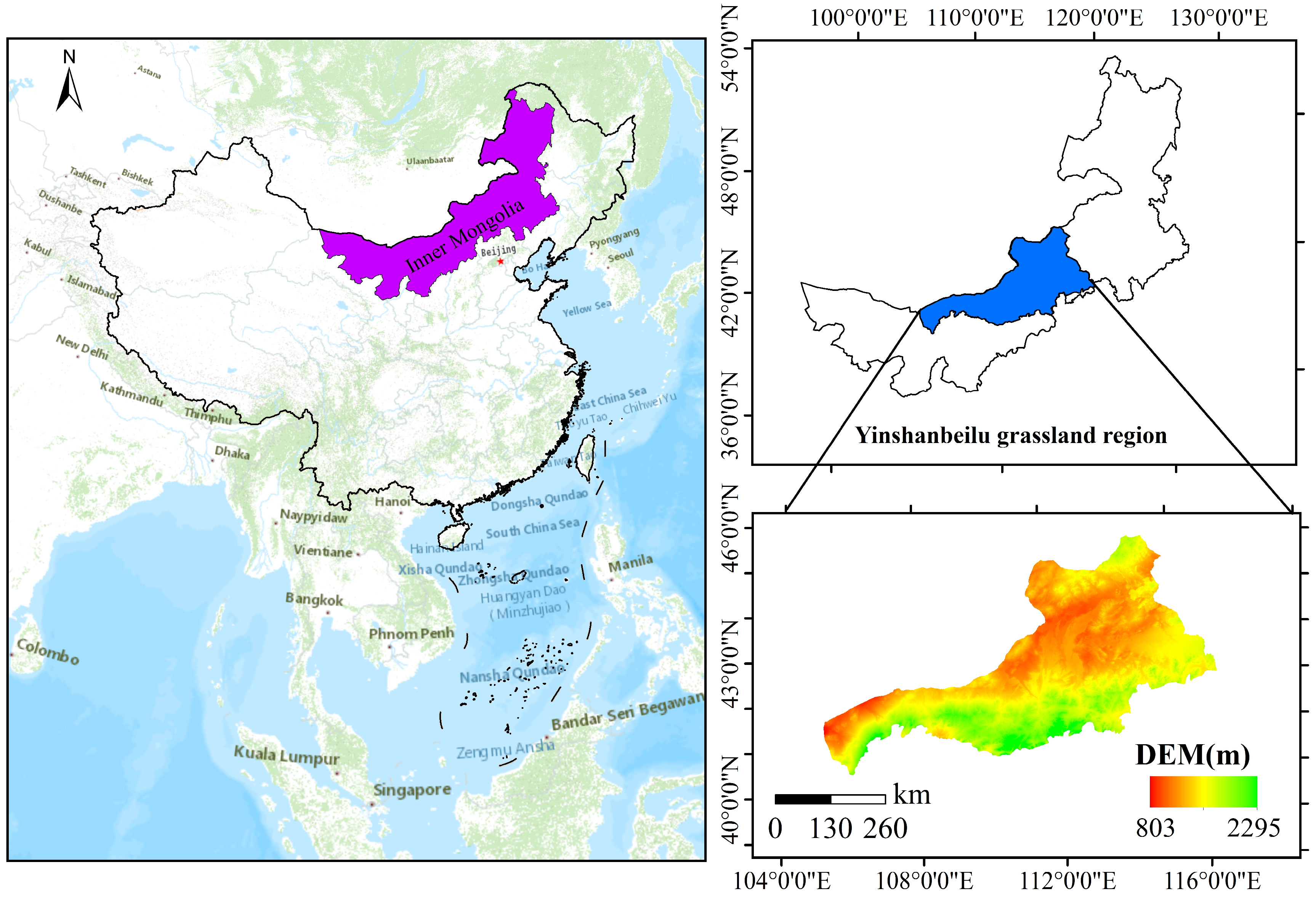
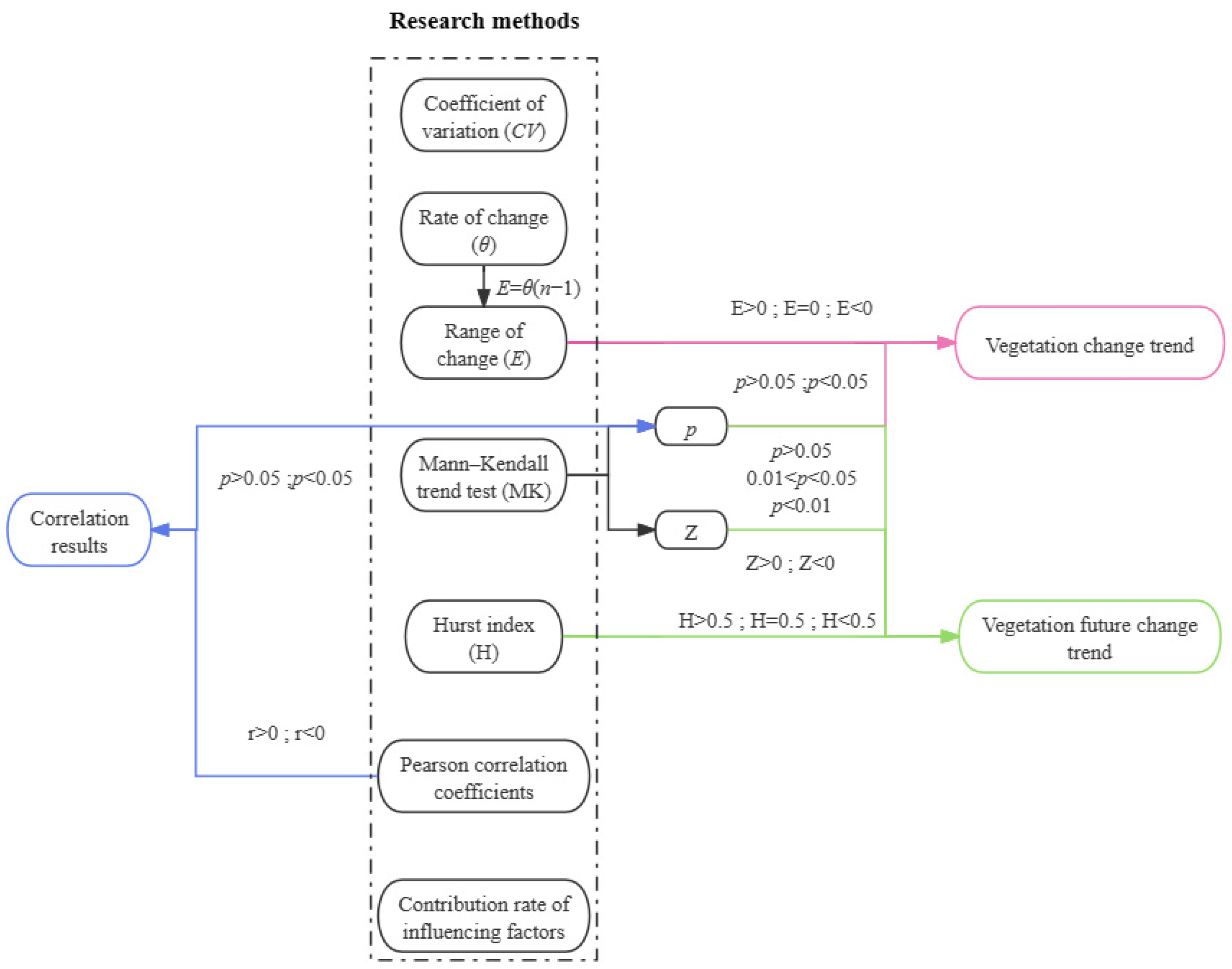
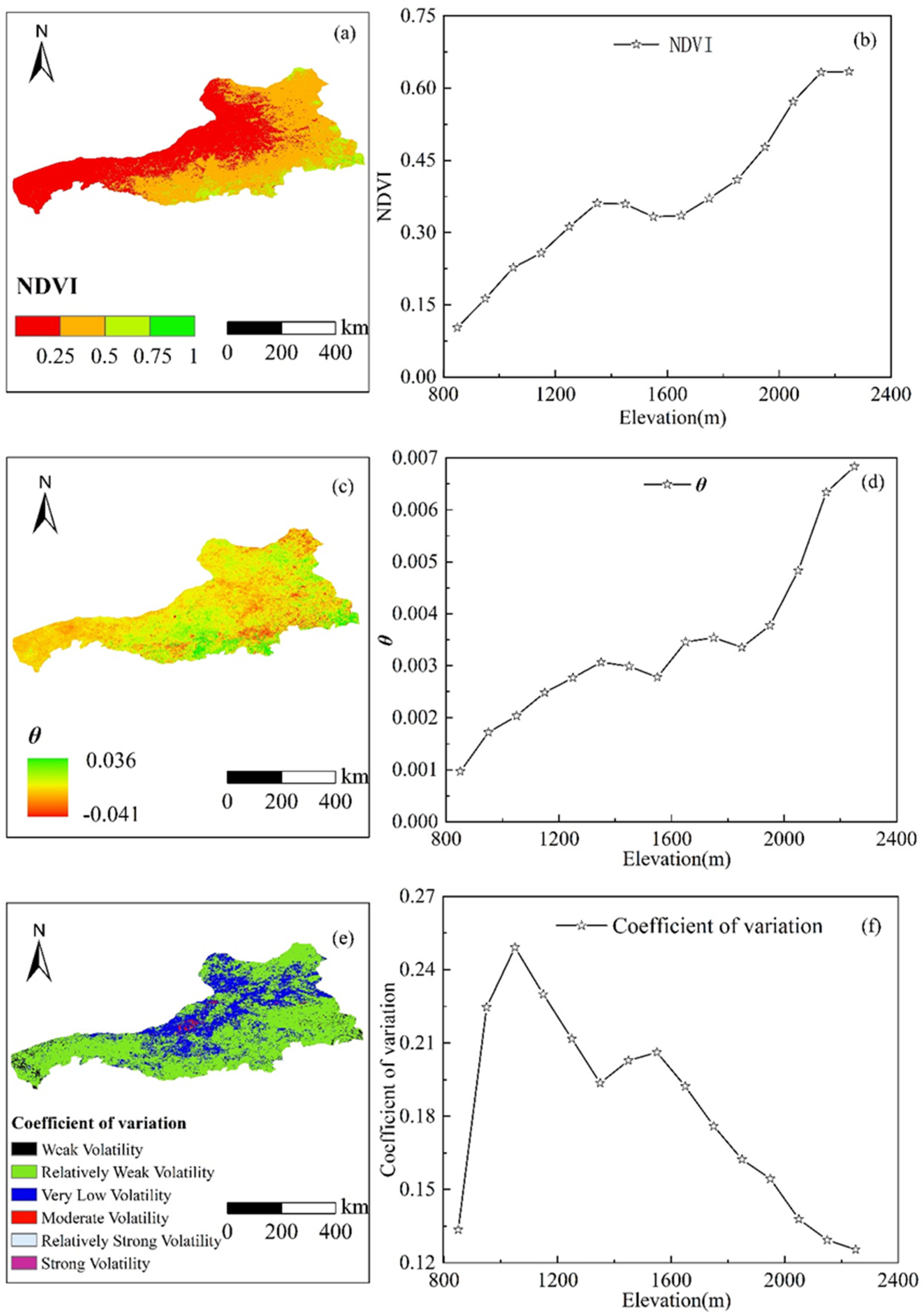

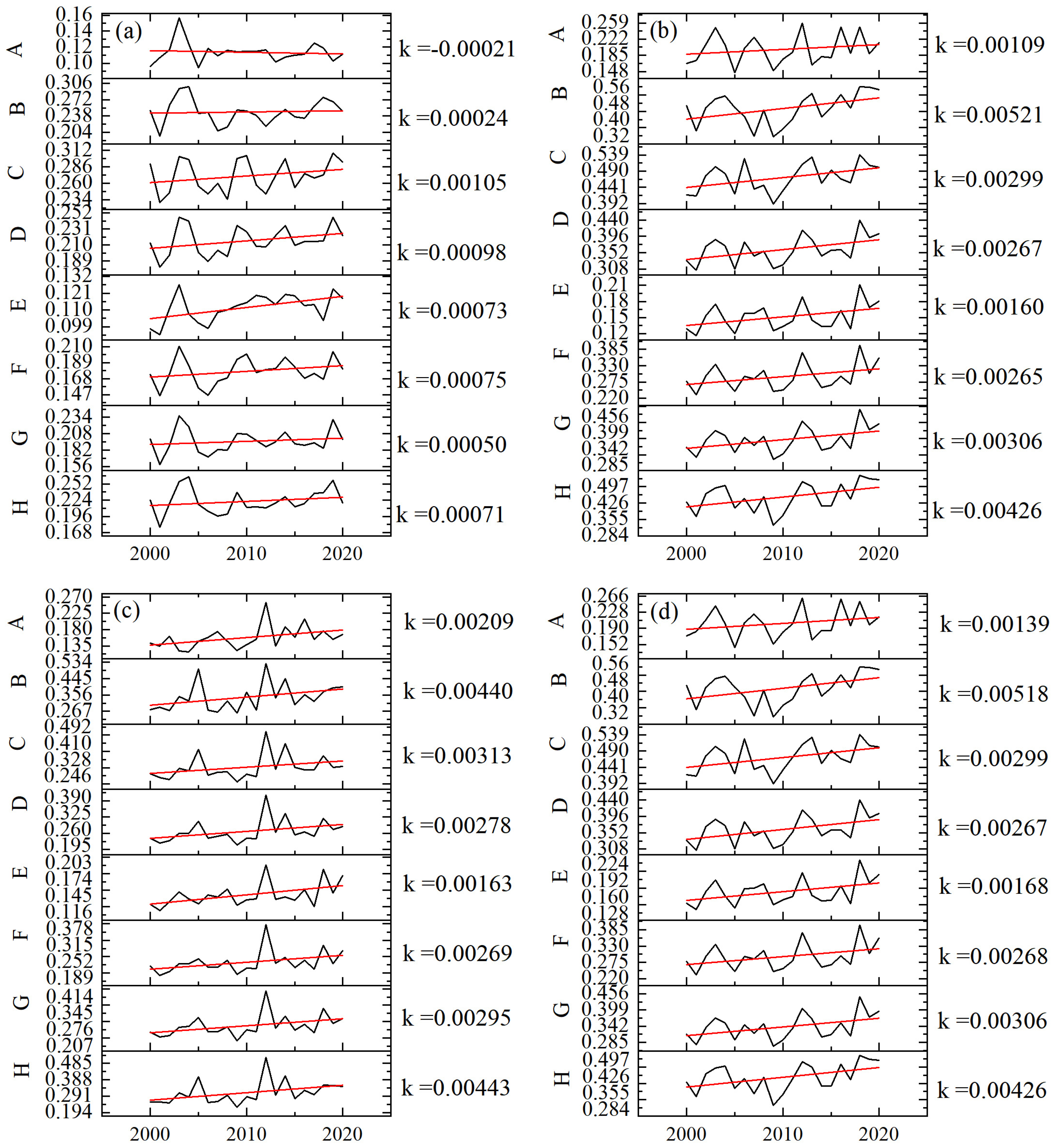

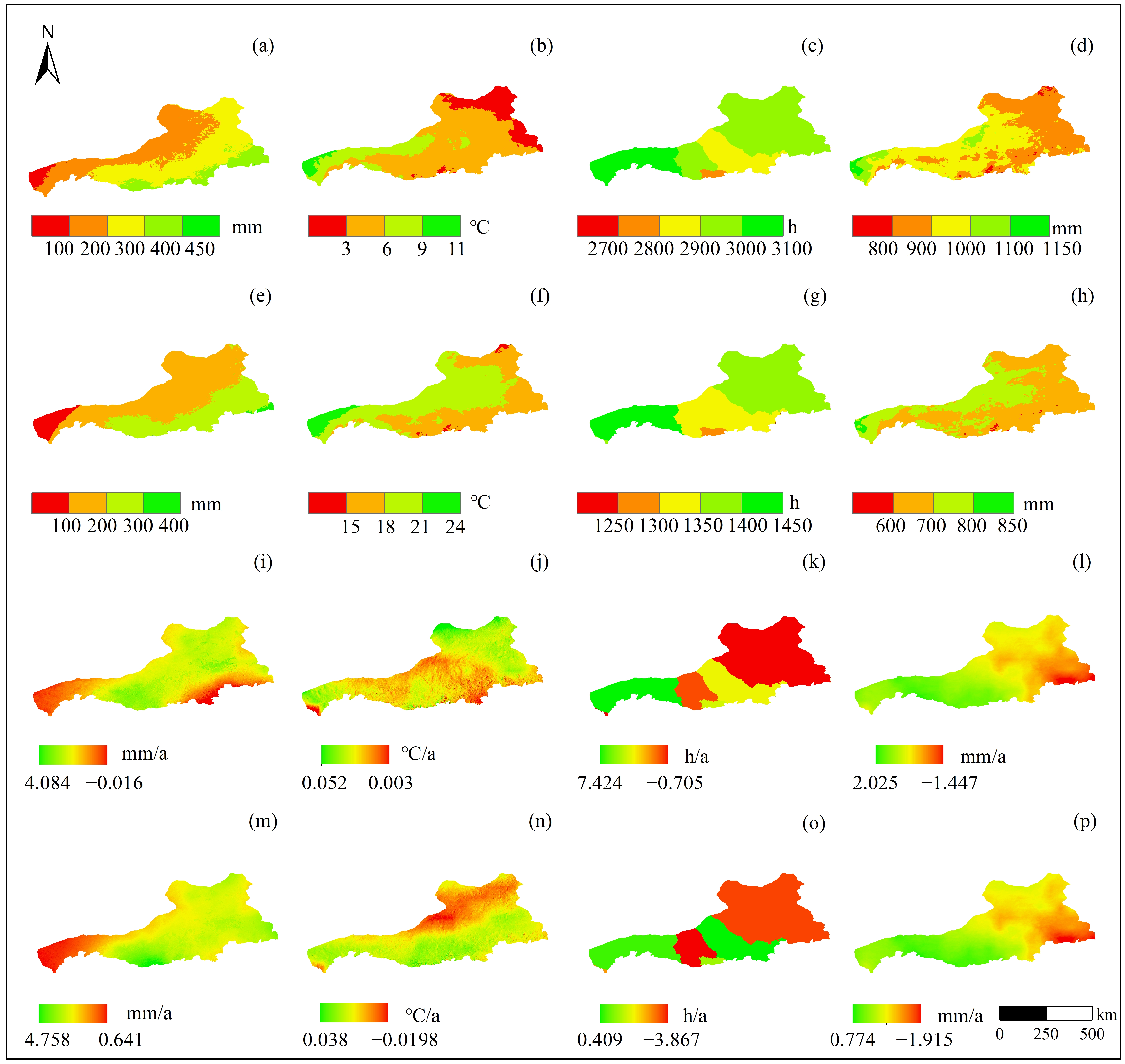
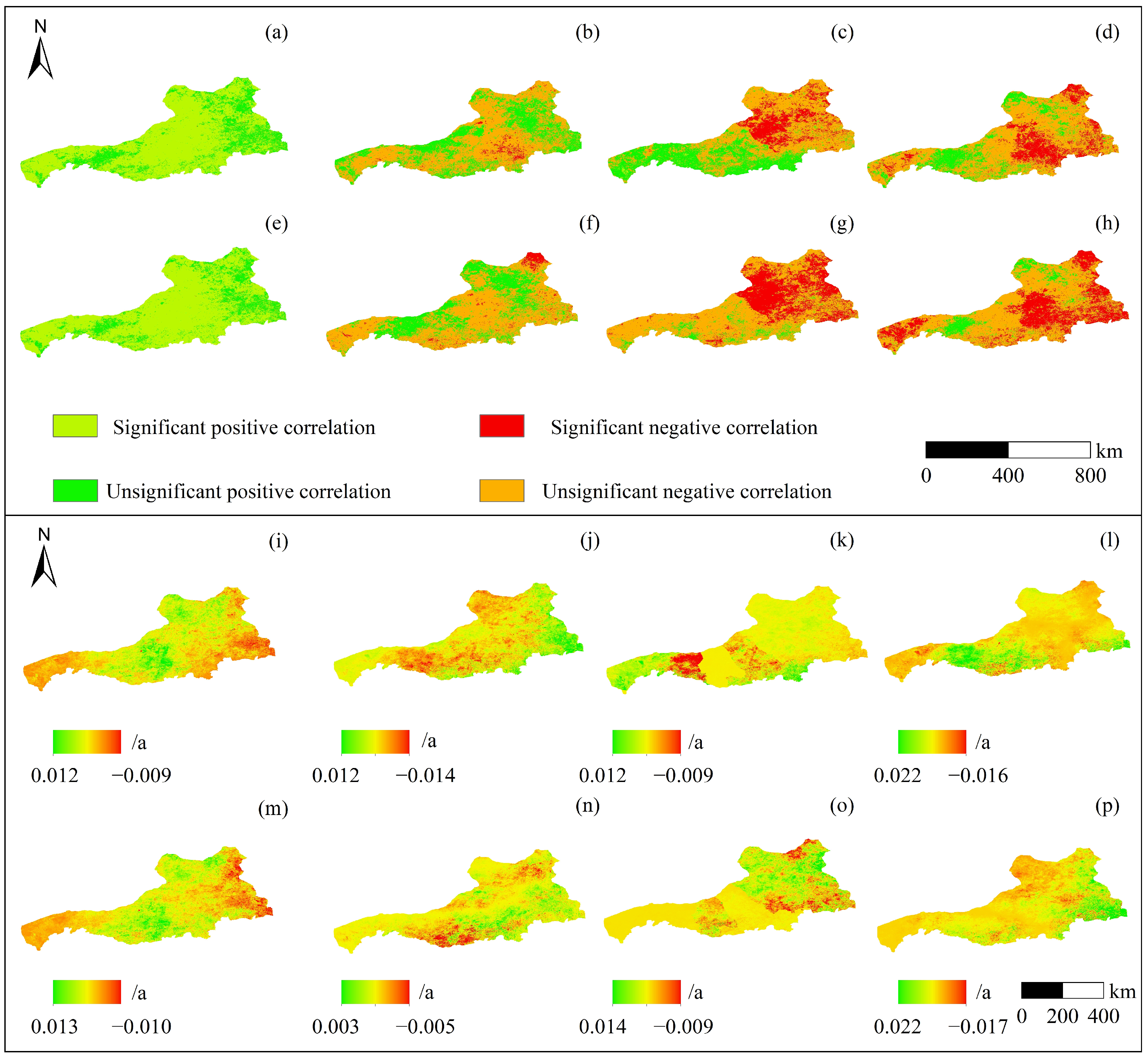

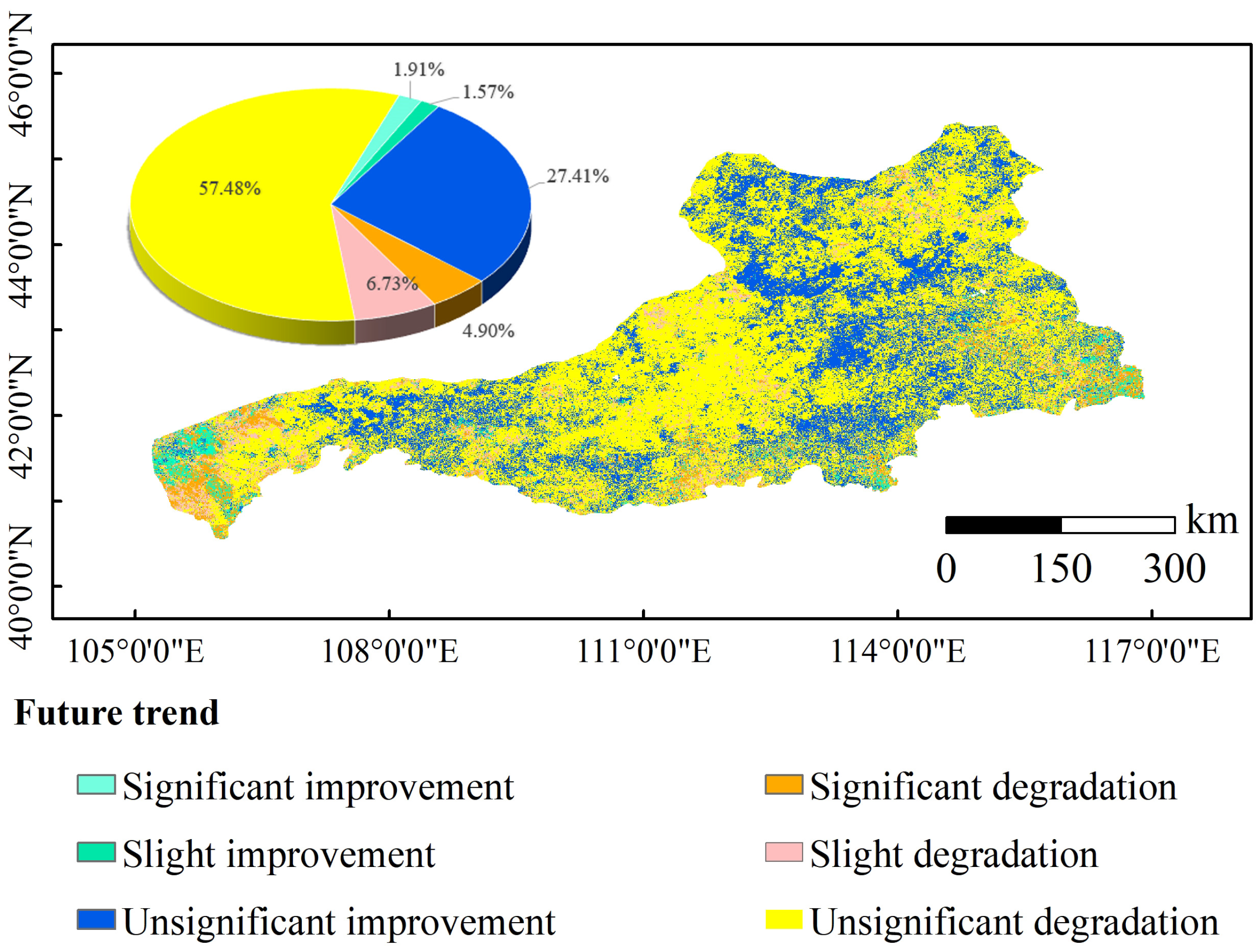
| Dataset | Source | Notes |
|---|---|---|
| NDVI | NASA Space Earth data (https://ladsweb.modaps.eosdis.nasa.gov/) (accessed on 8 May 2023) | A spatial resolution of 500 m × 500 m with a 16-day interval was used for the period 2000–2020. |
| Precipitation | National Earth System Science Data Center, National Science & Technology Infrastructure of China (http://www.geodata.cn/) (accessed on 11 May 2023) | A spatial resolution of 1000 m ×1000 m and a temporal resolution of 1 month. |
| Temperature | National Earth System Science Data Center, National Science & Technology Infrastructure of China (http://www.geodata.cn/) (accessed on 6 May 2023) | A spatial resolution of 1000 m ×1000 m and a temporal resolution of 1 month. |
| Potential evapotranspiration | National Earth System Science Data Center, National Science & Technology Infrastructure of China (http://www.geodata.cn/) (accessed on 7 May 2023) | A spatial resolution of 1000 m ×1000 m and a temporal resolution of 1 month. |
| Cumulative sunshine hours | National Meteorological Information Center-China Meteorological Website (http://data.cma.cn/) (accessed on 13 May 2023) | Using the inverse distance weighting method to interpolate the monthly data to obtain the monthly cumulative sunshine hours and hours data. |
| Vegetation types | Resource and Environment Science and Data Center (https://www.resdc.cn/) (accessed on 6 May 2023) | A spatial resolution of 1000 m × 1000 m. |
| Population distribution | LandScan global population dynamic crowding analysis database (https://landscan.ornl.gov/) (accessed on 23 August 2023) | A spatial resolution of 1000 m × 1000 m and a time interval of 1 year. |
| Coniferous Forest | Broadleaf Forest | Meadow | Bushes | Grassland | Cultivated Vegetation | Desert | Others | |
|---|---|---|---|---|---|---|---|---|
| Average NDVI | 0.495 | 0.471 | 0.339 | 0.361 | 0.294 | 0.453 | 0.153 | 0.206 |
| Average θ (a−1) | 0.005 | 0.003 | 0.003 | 0.003 | 0.003 | 0.004 | 0.002 | 0.001 |
| Average CV | 0.187 | 0.145 | 0.216 | 0.174 | 0.228 | 0.200 | 0.207 | 0.455 |
| Vegetation Type | Spring (March–May) (a−1) | Summer (June–August) (a−1) | Autumn (September–November) (a−1) | Growing Season (May–September) (a−1) |
|---|---|---|---|---|
| Coniferous forest | 0.00024 | 0.00521 | 0.0044 | 0.00518 |
| Broadleaf forest | 0.00105 | 0.00299 | 0.00313 | 0.00299 |
| Meadow | 0.00050 | 0.00306 | 0.00295 | 0.00306 |
| Bushes | 0.00098 | 0.00267 | 0.00278 | 0.00267 |
| Grassland | 0.00075 | 0.00265 | 0.00269 | 0.00268 |
| Cultivated vegetation | 0.00071 | 0.00426 | 0.00443 | 0.00426 |
| Desert | 0.00073 | 0.00160 | 0.00163 | 0.00168 |
| Others | −0.00021 | 0.00109 | 0.00209 | 0.00139 |
| Average NDVI | Climate Factors | Human Factors | ||||
|---|---|---|---|---|---|---|
| Precipitation | Temperature | Accumulated Sunshine | Potential Evapotranspiration | |||
| Annual (a−1) | 0.00267 | 0.00173 | −0.00027 | 0.00006 | 0.00074 | 0.00041 |
| Growing season (a−1) | 0.00267 | 0.00180 | −0.00001 | 0.00021 | 0.000595 | 0.00007 |
| Vegetation Trends | 2000 (Person/km2) | 2010 (Person/km2) | 2020 (Person/km2) |
|---|---|---|---|
| Significant Improvement | 10.24 | 9.42 | 8.84 |
| Significantly Degraded | 25.23 | 43.16 | 62.23 |
| Insignificantly Degraded | 10.72 | 9.83 | 9.17 |
| Insignificant Improvement | 6.00 | 4.99 | 4.40 |
| Stability | 6.39 | 5.95 | 4.66 |
Disclaimer/Publisher’s Note: The statements, opinions and data contained in all publications are solely those of the individual author(s) and contributor(s) and not of MDPI and/or the editor(s). MDPI and/or the editor(s) disclaim responsibility for any injury to people or property resulting from any ideas, methods, instructions or products referred to in the content. |
© 2024 by the authors. Licensee MDPI, Basel, Switzerland. This article is an open access article distributed under the terms and conditions of the Creative Commons Attribution (CC BY) license (https://creativecommons.org/licenses/by/4.0/).
Share and Cite
Tuo, M.; Xu, G.; Zhang, T.; Guo, J.; Zhang, M.; Gu, F.; Wang, B.; Yi, J. Contribution of Climatic Factors and Human Activities to Vegetation Changes in Arid Grassland. Sustainability 2024, 16, 794. https://doi.org/10.3390/su16020794
Tuo M, Xu G, Zhang T, Guo J, Zhang M, Gu F, Wang B, Yi J. Contribution of Climatic Factors and Human Activities to Vegetation Changes in Arid Grassland. Sustainability. 2024; 16(2):794. https://doi.org/10.3390/su16020794
Chicago/Turabian StyleTuo, Mengyao, Guoce Xu, Tiegang Zhang, Jianying Guo, Mengmeng Zhang, Fengyou Gu, Bin Wang, and Jiao Yi. 2024. "Contribution of Climatic Factors and Human Activities to Vegetation Changes in Arid Grassland" Sustainability 16, no. 2: 794. https://doi.org/10.3390/su16020794
APA StyleTuo, M., Xu, G., Zhang, T., Guo, J., Zhang, M., Gu, F., Wang, B., & Yi, J. (2024). Contribution of Climatic Factors and Human Activities to Vegetation Changes in Arid Grassland. Sustainability, 16(2), 794. https://doi.org/10.3390/su16020794




